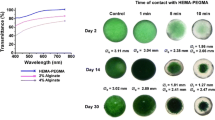Abstract
As the concern towards environmental deterioration grows worldwide, new technological achievements become essential for all countries. Among the technologies with great potential of bioremediation is microencapsulation of active material. Several studies have investigated the use of controlled release of active materials as a way of biostimulation and supplying the nutrients necessary for the bioremediation process. In fact, as the use of microorganisms has a great potential in degrading crude oils, this work aims to use that technology and to associate it to produce controlled-release capsules of nitrogen, phosphorus, and potassium (N, P, and K) for bioremediation purposes. For the capsule formulation, polymers of sodium alginate, Capsul®, and the commercial fertilizer NPK from Sempre Verde Inc. were used. Crude oil was the only carbon source and mineral medium for microorganism growth. Controlled-release nutrient capsules, with 4 mm in diameter, made of 3.0 % alginate (w/v) and 4.0 % Capsul® (w/v) were produced. Those capsules were used in association with a microbial consortium, in a liquid phase bioremediation process, having degraded 43.6 % of the total hydrocarbon within 240 h, evidencing thus as a promising tool for hydrocarbon bioremediation.





Similar content being viewed by others
References
Franco, I., Contin, M., Bragato, G., & De Nobili, M. (2004). Geoderma, 121(1–2), 17–30.
Ayotamuno, M. J., Kogbara, R. B., Ogaji, S. O., & Probert, S. D. (2006). Applied Energy, 83(11), 1249–1257.
Rizzo, A. C., Santos, R. M., Cunha, C. D., Magalhães, H. M. L., Leite, S. G. F., & Soriano, A. U. (2008). Journal of the Brazilian Chemical Society, 19(1), 169–174.
Salinas-Martinez, A., Santos-Cordova, M. L., Soto-Cruza, O., Delgadoa, E., Prez-Andrade, H., Hauad-Marroquyn, L. A., & Medrano-Rolda, H. (2000). Journal of Environmental Management, 88(1), 115–119.
Coulon, F., Mckew, B. A., Osborn, A. M., Mcgenity, T. J., & Timmis, K. N. (2007). Environmental Microbiology, 9(1), 177–186.
Rosa, P. A., & Triguis, J. A. (2007). Environmental Science and Pollution Research – International, 14(7), 470–476.
Yu, K. S., Wong, A. H., Yau, K. W., Wong, Y. S., & Tam, N. F. (2005). Marine Pollution Bulletin, 51(8–12), 1071–1077.
Dibble, J. T., & Bartha, R. (1979). Applied and Environmental Microbiology, 37(4), 729–739.
Gotvajn, A. Ž., & Zagorc-Končan, J. (2009). Desalination, 248(1–3), 794–802.
Bastos, D. S., Gomes, K., & Rocha-Leao, M. H. M. (2009). Journal of Microencapsulation., 26, 97–103.
Thies, C. (1996). Microencapsulation, vol. 73. In S. Benita (Ed.), A survey of microencapsulation processes (pp. 1–19). New York: Marcel Dekker.
Arburto, L. C., Tavares, D. Q., & Martucci, E. T. (1998). Revista Ciência e Tecnologia de Alimentos, 18(1), 45–48.
Liang, R., & Liu, M. (2006). Journal of Agricultural and Food Chemistry, 54(4), 1392–1398.
Wu, L., Liu, M., & Rui, L. (2008). Bioresource Technology, 99(3), 547–554.
Xu, R., Lau, A. N., Lim, Y. G., & Obbard, J. P. (2004). Journal of Environmental Quality, 33(4), 1210–1216.
Xu, R., Lau, A. N., Lim, Y. G., & Obbard, J. P. (2005). Marine Pollution Bulletin, 51(8–12), 1062–1070.
Xu, R., Obbard, J. P., & Tay, E. C. T. (2003). World Journal of Microbiology and Biotechnology, 19(7), 719–725.
Cunha, C. D., & Leite, S. G. F. (2000). Brazilian Journal of Microbiology, 31(1), 45–49.
Lowry, O. H., Rosebrough, N. J., Farr, A. L., & Randall, R. J. (1951). Journal of Biological Chemistry, 193(1), 265–275.
Zaia, D. A. M., Zaia, C. T. B. V., & Lichtig, J. (1998). Química Nova, Brasil, 21(6), 787–793.
United States Environmental Protection Agency. (1999), Office of Water, United States Environmental Protection Agency, Washington, DC.
Gumí, T., Gascón, S., Torras, C., & Valls-Garcia, R. (2009). Desalination, 245(1–3), 769–775.
Paula, H. C. B., Oliveira, E. F., Abreu, F. O. M., Paula, R. C. M., Morais, S. M., & Forte, M. M. C. (2010). Polímeros, 20(2), 112–120.
Shahidi, A., & Han, X. Q. (1993). Critical Reviews in Food Science and Nutrition, 33(6), 501–547.
United States Environmental Protection Agency 2011. Available from: www.epa.gov. Accessed 20 May 2011.
Acknowledgments
The authors would like to thank Coordenação de Aperfeiçoamento de Pessoal de Nível Superior, Fundação de Amparo à Pesquisa do Estado do Rio de Janeiro, and Conselho Nacional de Desenvolvimento Científico e Tecnológico for financial support which helped to implement the present work.
Author information
Authors and Affiliations
Corresponding author
Rights and permissions
About this article
Cite this article
Reis, E.A., Rocha-Leão, M.H.M. & Leite, S.G.F. Slow-Release Nutrient Capsules for Microorganism Stimulation in Oil Remediation. Appl Biochem Biotechnol 169, 1241–1249 (2013). https://doi.org/10.1007/s12010-012-0022-0
Received:
Accepted:
Published:
Issue Date:
DOI: https://doi.org/10.1007/s12010-012-0022-0




